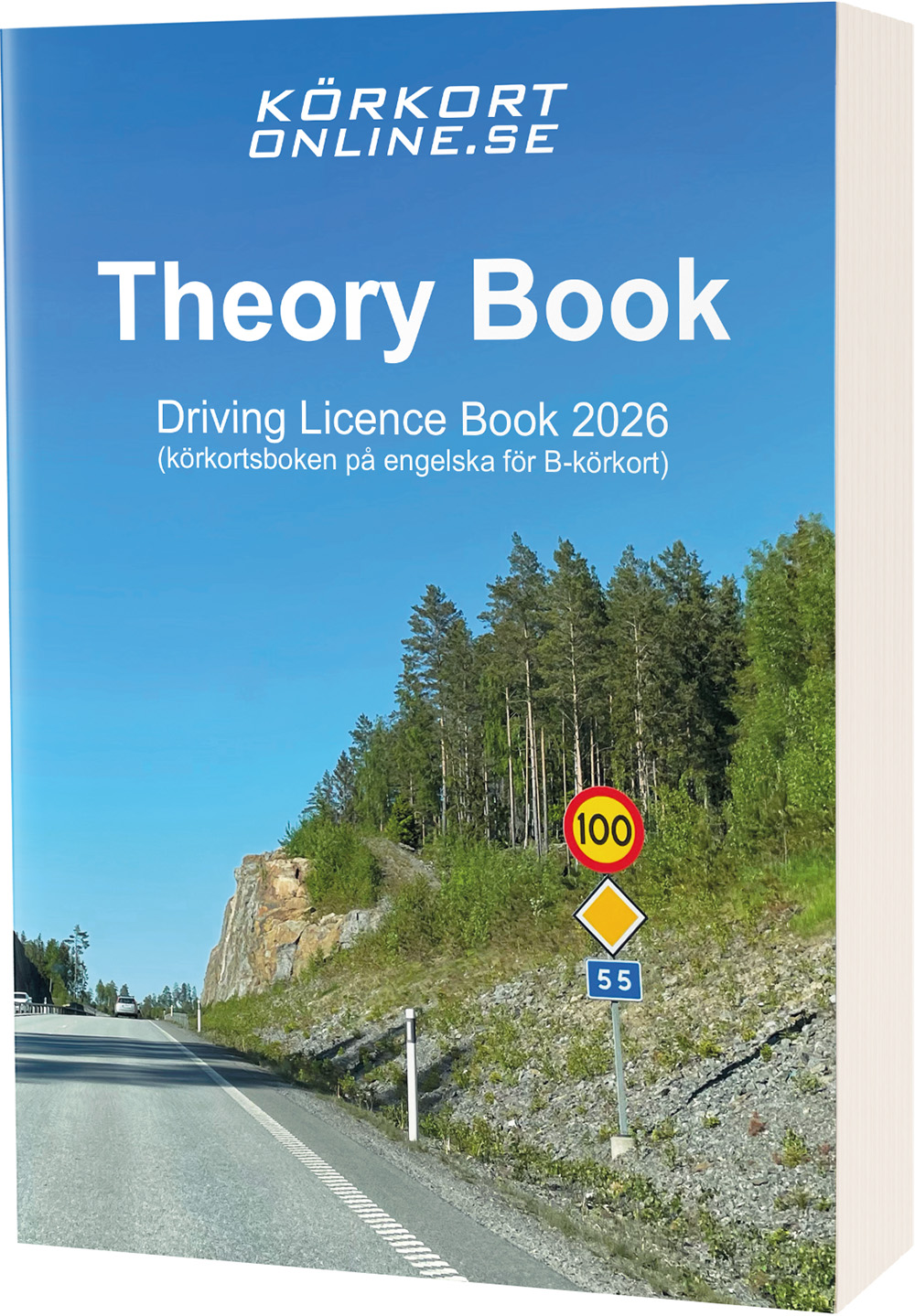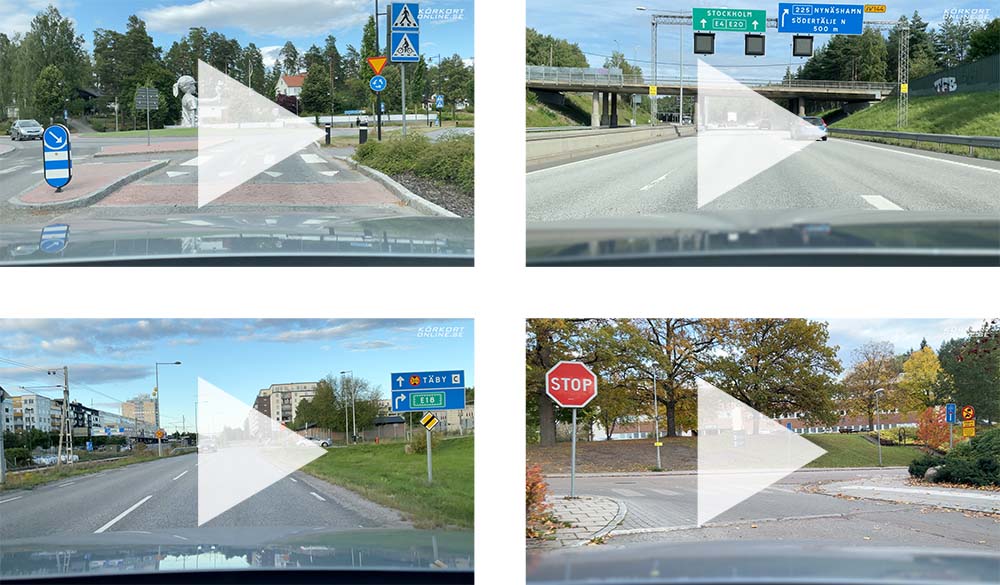Traffic accidents – driving licence theory
Humans are designed to walk and run. Driving a car is unnatural for us, as the speed is very high (compared to walking) and our bodies are not made to withstand the impact of a collision.
Causes of accidents
There are three main causes of traffic accidents:
- Human error.
- Unsafe roads.
- Unsafe vehicles.
Prone to accidents
The same group, around 15% of the population, are involved in 50% of all accidents. The characteristics of this group increase the risk of accidents – for example, they:
- Make excuses for their mistakes, which means they do not learn from them.
- Deny the dangers – for example, by ignoring the fact that there is a preschool nearby.
- Act impulsively, which can cause dangerous situations, such as making a sharp turn without indicating.
- Are proud, which can lead to a negative reaction if they get overtaken.
- Have a need for self-assertion, which means that they need to show how big and strong they are.
- Are prone to reaction formation, which is a form of contradictory behaviour. Those who are careful in other contexts use traffic to vent their frustration and other feelings.
- Party a lot, which leads to late-night driving (tiredness) and drunk driving.
- Are adventurous. Some drivers view traffic as a challenge and an opportunity for racing.
What to do in the event of a major accident
If you are one of the first to arrive at the scene of an accident
- Survey the scene
Number of casualties? Other risks? - Prioritise
What needs to be done first? Person in a burning car? - Warn
If visibility is limited, there is a risk of more cars colliding, thus making the situation worse. - Call 112
Location, number of casualties.
First aid
- Life-threatening situations
Move any person lying in the middle of the road or sitting in a burning car. - Breathing
Find out if immobile persons are breathing. If the person is breathing, put them in the recovery position. If the person is not breathing:- No pulse
Cardiopulmonary resuscitation (CPR) is required. - Has a pulse
Mouth-to-mouth resuscitation.
- No pulse
- Bleeding
Stop the bleeding by applying pressure and tying a piece of fabric around the wound. - Shock
Does not refer to people who have been scared, but to circulatory shock, which involves life-threatening internal damage (bleeding). The person will often be pale and experience cold-sweats. Make sure the person is breathing properly and do not give them anything to drink.
Remember
- Stay at the scene of the accident until the emergency responders have taken over and you have given them all the information they ask for. If you leave too soon, it may be considered absconding, which is punishable.
- Exception: If you did not witness the accident and you see that a lot of people have already stopped, you should not stop yourself, as this can lead to more accidents and also hinder the emergency response vehicles.
- You must give your name and other information requested of you, even if it is a private individual involved in the accident who is asking.
- You may not move anything at the scene of the accident.
- Exception: If the vehicle/object poses a danger to other road users, you should move it.
- The police must always be contacted if someone has been injured in the accident.
Dangerous goods
Do not approach lorries marked with signs indicating dangerous goods. Such cargo can be lethal if there is a leak. There may also be a high risk of explosion.
What to do in the event of a minor accident
You should keep an insurance claim form (provided by your insurance company) in your car. If you do not have one, write down:
- The time, date and location of the accident.
- The name and address of any witnesses, and what they have seen.
- The counterparty’s name, address, telephone number, vehicle, registration number and insurance company.
- Any damage caused.
Parking accident or similar
- In the event of a parking accident or other property damage, you must contact the owner of the car or the object that you have run into. The Swedish Transport Agency can help you find information about the owner based on the vehicle registration number.
- Also put a note with your contact information on the windscreen/location.
- If you are unable to reach the owner, you must contact the police. They will make a note of the accident, which means that you will not be accused of absconding.
If the object you have damaged is a road sign, you must immediately try to restore it. If you are unable to, contact the police and warn other road users.
Wildlife accidents
Greatest risk of wildlife on the road
- At dusk and dawn.
- May–June and September–October.
- On salted roads.
- Close to open fields.
- Close to a watercourse.
- At the start and end of a wildlife fence.
Accidents involving elk (moose)
Accidents involving elk are the most dangerous type of wildlife accident. The reason for this is that the body of the elk, which weighs around 700 kg, is at the height of the windscreen of the car. In case of a head-on collision, there is a great risk of the elk ending up inside the car, injuring the passengers.
Once an elk has started crossing the road, it will in all likelihood continue straight ahead. It is therefore best to go behind the elk, if you have to choose which way to swerve.
What to do if you hit a large animal
- Warn other road users with your hazard warning lights and warning triangle.
- If the animal is dead, try to move it away from the road. If the animal is wounded and runs away, you must mark the location of the accident. This will make it easier for a hunter to track the wounded animal.
- If the animal is wounded, you are obliged to inform the police. You are also obliged to contact the police if the animal you hit (regardless of whether it is wounded) is one of the following:
- Bear
- Wolf
- Wolverine
- Lynx
- Elk
- Deer
- Roe deer
- Otter
- Wild boar
- Mouflon sheep
- Eagle
The warning stretches for 800 metres from the sign. However, that does not guarantee that the road will be free from animals after 800 metres.
Warning triangle
All cars must be equipped with a warning triangle. If your car stalls on a road where the speed limit is over 50 km/h, you must display a warning triangle. Place the warning triangle 50–100 metres behind the car.
Clarification of “over 50 km/h”
You have to display a warning triangle if the speed limit is over 50 km/h. In practice, this means that you only have to display it once the speed limit is 60 km/h (which is the next step on the speed scale). Think of it this way: 50 km/h is not “over” 50 km/h (it is exactly 50 km/h).
Traffic accident statistics
Approximate numbers
- Number of deaths: 220 per year.
- Severe injuries: 2,000 per year.
- Mild injuries: 15,000 per year.
- 20% of all traffic deaths are related to the use of drugs or alcohol..
- 40% of all those killed in traffic were not wearing a seat belt.
- 75% of all those killed in traffic are men.
- 75,000 wildlife accidents occur each year.
- Risk of a pedestrian being killed if hit by a car:
- 10% risk of fatality at 30 km/h.
- 80% risk of fatality at 50 km/h.
- Almost 100% risk of fatality at 90 km/h.
Different age groups
- 18–19 years: Run a 5–6 times greater risk of being involved in a traffic accident compared to the average.
- 45–54 years: Have the best reaction times.
- 65–74 years: Have experience and adapt their driving to their limitations (for example, by avoiding driving at night or in heavy traffic).
- 75 years and older: Run a 5–6 times greater risk of being involved in a traffic accident compared to the average.
Be extra careful

You are warned of a junction where the priority-to-the-right rule applies.
- When turning left on a country road.
- At junctions where the priority-to-the-right rule is applicable.
- While overtaking.
- In dense queues.
- At weekends (Friday, Saturday and Sunday).
- During summer months (June, July and August).
- Late at night (02.00–05.00).
Accident locations
- Most accidents occur in built-up areas. This is primarily due to the greater concentration of cars and other road users.
- The most serious accidents occur outside of built-up areas. This is primarily due to the greater speeds.
High level of safety in Sweden
Sweden ranks very highly in international comparisons of traffic safety.
In the United States there are around 40,000 traffic deaths per year. Adjusted to population, that number is almost six times higher than in Sweden.
Traffic deaths per year
| Year | Number of deaths |
| 1950 | 595 |
| 1960 | 1,036 |
| 1970 | 1,307 |
| 1980 | 848 |
| 1990 | 772 |
| 2000 | 591 |
| 2010 | 266 |
| … | … |
| 2022 | 227 |
| 2023 | 229 |
| 2024 | 213 |
- Even though traffic is increasing, the number of fatal accidents is decreasing.
- In 1950, there were around 345,000 motor vehicles in Sweden and 595 traffic deaths. Today there are more than 5,500,000 motor vehicles and the number of deaths is below 300 per year. The number of deaths per motor vehicle has declined by 97% during that time.
- In 1965, 1,313 people were killed in traffic accidents, which makes it the deadliest year in Swedish history. That number corresponds to 1 death per 22 million vehicle kilometres. Today, the number of deaths is 1 per 300 million vehicle kilometres. That is a reduction of over 90%.
Number of deaths according to accident type
| Accident type | Number of deaths (2024) |
| Turning off from a road | 6 |
| Bicycle and moped | 28 |
| Pedestrians | 30 |
| Junction | 15 |
| Head-on collision | 51 |
| Overtaking | 2 |
| Single-vehicle | 61 |
| Catching up (rear-end collision) | 5 |
| Animals | 2 |
| Other | 13 |
Vision Zero
- In 1997, the Swedish Parliament adopted a new long-term strategy for road safety. The goal is to achieve zero fatalities or injuries on Sweden’s roads.
- The focus is to strategically remove the risks (for example, by having safer cars and adding more cable barriers). Driver education is also important, although people will always make mistakes.
A few words on statistics
The driving licence book involves statistics that may feel like unnecessary knowledge. However, there is a reason for the statistics. For example:
Why do I need to know that 40% of those killed in traffic did not wear a seatbelt?
– The aim is to make you realise how important the seatbelt is. You can also use that number if a passenger claims that the seatbelt is “unnecessary”.
Why do I need to know that there are 75,000 wildlife accidents per year?
– If you believe that there are 10 wildlife accidents per year, you might not respect the signs warning of wild animals. If you know that the number is 75,000, you will be extra careful when you see a sign warning of wild animals.
Latest forum posts
- << Children
- Traffic accidents ↑↑
- Vehicle terms >>





